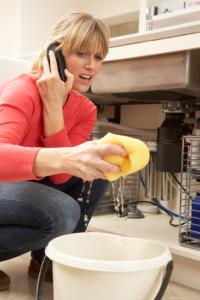We all fear the day our bathroom floods. If a toilet runs over or a pipe breaks, it can quickly turn into nightmare. Just as it’s important to understand how to change a tire, knowing what to do during a bathroom flood can make the difference between a minor inconvenience and a costly crisis. In this article we’ll discuss how to manage and recover after a bathroom flooding disaster.
Shut off the Source
The very important first step when the water starts flowing is to shut it off. Don’t first fetch a bucket, don’t go for the plunger, and don’t reach for the towels. The best way to prevent a devastating flood is to find the water and shut it down as soon as possible.
Most water sources have local stops below them. For instance, your toilet should have a knob where the toilet meets the wall, near the floor. Turn the knob to the right, and you will shut off the water. The same goes for the pipes below sinks, or near dishwashers. Always twist to the right. If you can’t find where to shut off the water, call a professional immediately before moving on to other remediation.
Handle the Electricity
Once you have stopped the water, check to ensure that there are no electrics near the flood. If any appliances or outlets have become flooded, stay away from the water and turn off the electricity. Shut off all electricity in the room(s) that have flooded or are flooding. If you can’t find the main breaker, you smell gas, or you see sparks or flames, leave the home and call 911 immediately for assistance.
Soak Up the Water
Remove as much water as possible. If the water is spreading, use towels to corral it and prevent it from flooding further. Never, ever, ever use a vacuum to suck up water. Next, move furniture, pin up any textiles, and protect the legs of furniture by wrapping their feet in aluminum foil, saran wrap, or plastic bags. Open any windows in the area to help with air flow. And if you have a fan, point it toward the area to aid in the process of evaporation.
Protect Your Property
Open cabinets and pull up rugs. The bathtub is a great place to throw items that need to drain and dry. Do not leave anything on the floor that could bleed and stain, including magazines and books. Try your best to dry the area as quickly as possible; the longer water remains, the higher the possibility that mold will grow and further damage to the flooring will be incurred. Take notes and pictures, and call your insurance company for an assessment immediately. If they have a suggested professional, call and make an appointment so that you can limit the damage.
Fix it Quick
In case the point has not been belabored enough, it’s incredibly important to never wait to handle the after-effects flood. A quick and efficient clean-up process can save you thousands of dollars in headache and damage due to warped flooring, moldy carpet, ruined furniture, and zapped appliances—not to mention stress!
Be Prepared
The best plan of action is always prevention. Have the number of a professional on-hand in case of emergencies, and ensure you know where the breaker and the water shut-off valves reside within your home before you are in the middle of a potential disaster. We all hope it never happens to us, but in case it does, it’s important to be as prepared as possible in advance of such a stressful and potentially dangerous and costly household hazard.


 FREE Live Music and Family Fun at Allied Gardens First Fridays The next Allied Gardens First Fridays Summer Concert in the Park is just around the corner. Grab your lawn chairs, bring a picnic, and get ready to meet your
FREE Live Music and Family Fun at Allied Gardens First Fridays The next Allied Gardens First Fridays Summer Concert in the Park is just around the corner. Grab your lawn chairs, bring a picnic, and get ready to meet your  Ideal Plumbing Heating Air Electrical Named Winner of 2023 Better Business Bureau Torch Awards for Ethics in San Diego (San Diego, CA – September 15, 2023) Better Business Bureau Serving the Pacific Southwest (BBB) has named Ideal Plumbing Heating
Ideal Plumbing Heating Air Electrical Named Winner of 2023 Better Business Bureau Torch Awards for Ethics in San Diego (San Diego, CA – September 15, 2023) Better Business Bureau Serving the Pacific Southwest (BBB) has named Ideal Plumbing Heating